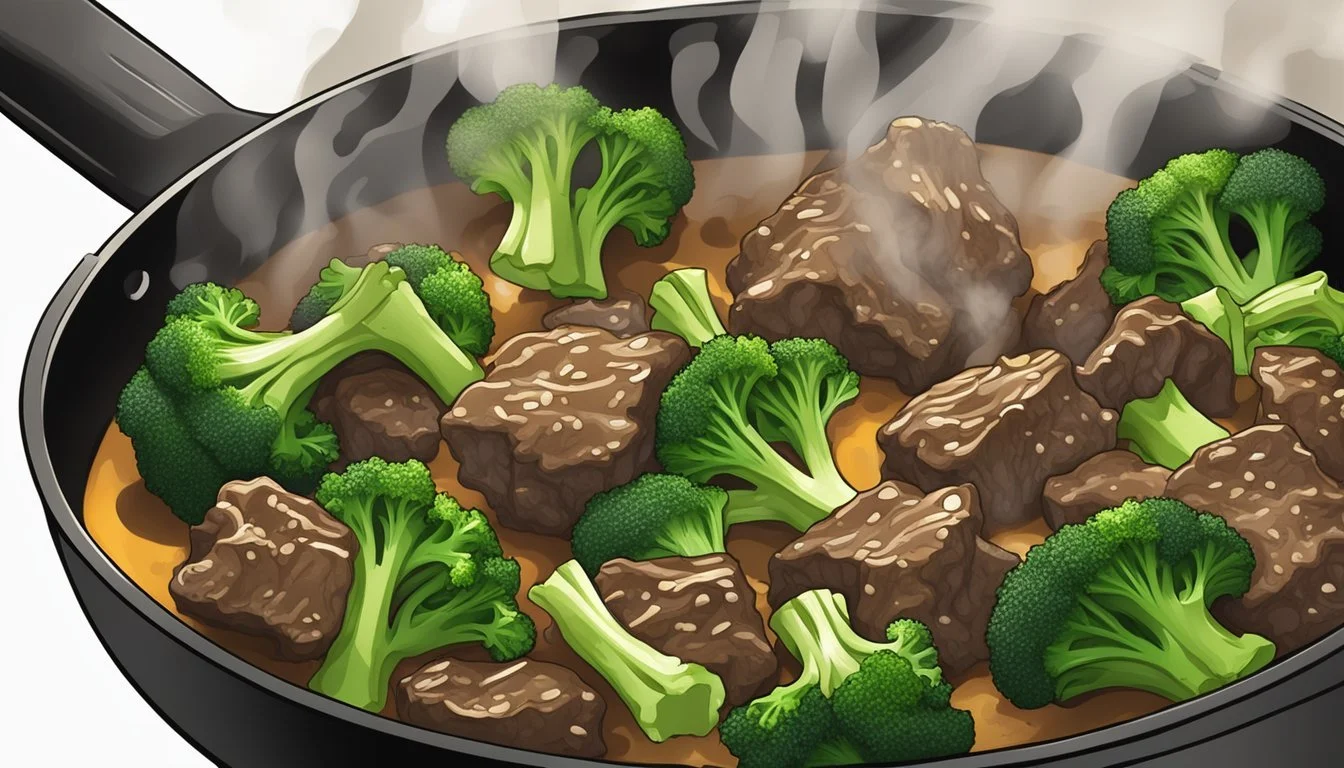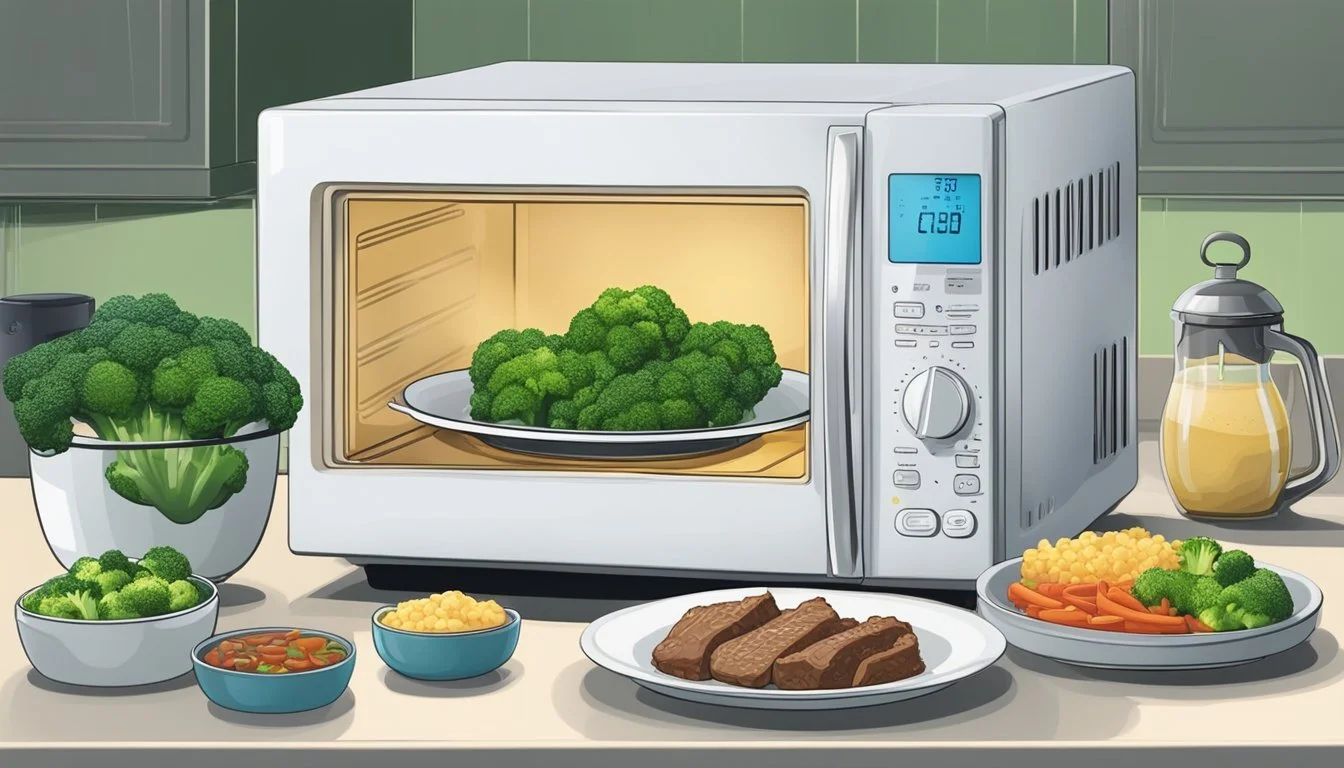How to Reheat Gluten-Free Beef and Broccoli
Best Methods and Tips
When enjoying a delicious gluten-free beef and broccoli dish, it’s common to have leftovers that need reheating. Reheating gluten-free meals can sometimes be tricky, but with the right methods, you can ensure the flavors and textures remain just right. The best way to reheat gluten-free beef and broccoli is by using a skillet on the stovetop, which helps maintain the dish's original taste and texture.
Place the beef and broccoli in a skillet over medium heat, adding a splash of water or gluten-free broth to prevent drying out. Stir occasionally until thoroughly heated, ensuring the beef retains its tenderness and the broccoli stays crisp yet tender. For those with limited time, using a microwave is also an option, although it might make the broccoli slightly softer. Cover the dish and heat in short intervals, stirring in between to ensure even heating.
These reheating techniques preserve the quality of your gluten-free beef and broccoli, making sure it tastes almost as good as when it was first cooked. Enjoy your reheated meal without compromising on the flavors that make this dish a favorite.
Understanding Gluten-Free Beef and Broccoli
Gluten-free beef and broccoli is a tasty and nutritious meal option when made correctly. It involves substituting gluten-containing ingredients with safe alternatives and properly reheating to maintain flavor and texture.
What Makes Beef and Broccoli Gluten-Free
To make beef and broccoli gluten-free, specific ingredients need to be replaced with gluten-free alternatives. Soy sauce, which typically contains wheat, can be swapped with gluten-free tamari or coconut aminos.
Thickening agents like regular flour should be replaced with arrowroot powder or tapioca starch for the sauce.
When restaurants or home cooks ensure these gluten-free substitutions, they prevent cross-contamination, making the dish safe for those with gluten sensitivities or celiac disease.
The Importance of Proper Reheating
Reheating gluten-free beef and broccoli correctly is crucial to preserve the dish's flavor, texture, and nutrient retention.
Leftovers should be stored in an airtight container in the fridge for up to 2-3 days. For reheating, use methods like low heat on the stove or microwaving at medium power to avoid overcooking.
Overheating can alter the texture of the beef and broccoli, making them tough or mushy. Proper reheating ensures the dish remains as delicious as when it was first cooked.
Preparation for Reheating
Proper preparation for reheating gluten-free beef and broccoli ensures that the dish remains delicious and retains its texture. Key aspects include storing leftovers correctly and selecting an appropriate reheating method.
Storing Leftover Beef and Broccoli
Leftover beef and broccoli should be stored in an airtight container to maintain freshness. After cooking, allow the leftovers to cool slightly before transferring them to the container.
Place the container in the refrigerator, where it can be stored for up to three days. This prevents moisture loss and contamination. If you plan to store the dish for longer, consider freezing it.
Label the container with the date to keep track of how long it has been stored. Frozen leftovers should be defrosted in the fridge overnight before reheating.
Choosing the Right Reheating Method
Several methods can be used to reheat gluten-free beef and broccoli. The microwave is a quick and convenient option. Place the dish on a microwave-safe plate and cover it with a damp paper towel to prevent drying out. Heat on high in 30-second intervals until warmed through.
For more even heating, use a skillet. Heat a small amount of oil in the skillet over medium heat. Add the beef and broccoli, stirring occasionally until heated evenly. This method helps maintain the texture of the broccoli and beef.
Alternatively, an oven can be used. Preheat to 350°F (175°C). Place the beef and broccoli in an oven-safe dish, cover with aluminum foil, and heat for about 15 minutes or until hot.
Avoid using the slow cooker or instant pot for reheating, as these can overcook the ingredients, leading to a mushy texture. Stick to methods that provide consistent and controlled heating to ensure the dish remains appetizing.
Reheating Methods
Reheating gluten-free beef and broccoli can be done effectively using various methods. Each method has its own advantages in terms of time, flavor retention, and convenience.
Microwave Reheating
Microwave rewarming is quick and efficient. Place the beef and broccoli in a microwave-safe dish. Add 1-2 tablespoons of water to help maintain moisture. Cover the dish with a microwave-safe lid or plate. Heat on high for 2-3 minutes, stirring halfway through to ensure even heating. This method is ideal for those needing a fast, easy reheating solution.
Stovetop Reheating
For stovetop reheating, use a skillet to preserve the flavors. Heat the skillet over medium heat and add a small amount of olive oil to prevent sticking. Once the skillet is hot, add the beef and broccoli. Stir occasionally and cook for about 5-7 minutes until heated through. This method helps maintain the texture and flavor of the ingredients.
Oven Reheating
Reheating in the oven is beneficial for preserving moisture. Preheat the oven to 250 degrees Fahrenheit. Wrap the beef in aluminum foil to keep it moist and place it on a baking sheet. Reheat for 15-20 minutes. If the broccoli was roasted, reheat it alongside the beef. This slow and even heating method prevents overcooking.
Instant Pot Reheating
Instant Pot reheating requires an added liquid. Place the beef and broccoli in the Instant Pot and add 1/4 cup of beef broth. Secure the lid and set the Instant Pot to the “Steam” setting for 5 minutes. Release the pressure naturally for a minute or two before opening. This method retains the dish's moisture and enhances its flavor.
Slow Cooker Reheating
For a slow cooker, add the beef and broccoli along with 1/4 cup of beef broth to the slow cooker. Set it to low heat and cook for about 2 hours until thoroughly warmed. This method is perfect for those who prefer a hands-off approach while still ensuring a flavorful, moist dish.
Additional Tips and Variations
Here are some practical ways to enhance the flavor and texture of your dish, as well as modify it to fit various dietary needs.
Enhancing Flavor and Texture
To make gluten-free beef and broccoli more flavorful, consider adding ginger and garlic. Fresh ginger and garlic can make the dish stand out with their bold flavors. Green onions can also add a touch of color and an extra layer of taste.
A sprinkle of sesame seeds can provide a pleasant crunch. Additionally, drizzling a bit of sesame oil at the end of cooking enhances the dish's depth. Using a high-quality, low-sodium tamari sauce or coconut aminos instead of regular soy sauce can make the sauce more nuanced.
When reheating, ensure the beef remains tender by warming it over low heat and adding a splash of broth or water to keep it moist. This prevents the meat from becoming tough or dry.
Adapting to Dietary Restrictions
For those following a dairy-free diet, ensure none of your additional ingredients contain hidden dairy products. This dish naturally aligns with dairy-free needs, making it quite accessible.
For a paleo version, use coconut aminos instead of tamari sauce, and opt for arrowroot powder instead of cornstarch. Those aiming for a low-carb meal can skip serving it over rice and use cauliflower rice instead. This maintains the dish’s heartiness while reducing carbohydrate intake.
Adding vegetables like bell peppers or zucchini can increase the nutrient content and cater to personal tastes or dietary requirements. For added spice, include red pepper flakes or sriracha.
These adjustments allow for a versatile and adaptable meal, ensuring it meets various preferences without sacrificing flavor.
Serving Suggestions
To maximize flavor and presentation, consider thoughtful pairings and garnishes that complement the gluten-free beef and broccoli and enhance your dining experience.
Pairing with Side Dishes
Rice is a classic choice that pairs well with gluten-free beef and broccoli, providing a neutral base that absorbs the savory sauce. Steamed jasmine or basmati rice are excellent options. Alternatively, cauliflower rice offers a low-carb alternative with similar texture.
For a more protein-rich option, quinoa can be used. It adds a slightly nutty flavor and additional nutrients. Cooked noodles, such as rice noodles, are also a popular pairing. Their texture complements the tender beef and crispy broccoli, creating a harmonious bite.
To add a bit of crunch and a different texture profile, consider serving toasted breadcrumbs on the side. This can create a delightful contrast with the softness of the beef and broccoli.
Garnishing for Presentation and Flavor
A well-chosen garnish can elevate the dish in both flavor and appearance. Toasted sesame seeds are a simple and effective choice, adding a subtle nuttiness and a pleasing visual contrast.
Additionally, a drizzle of apple cider vinegar or soy sauce can enhance the dish's overall taste by adding a touch of acidity and saltiness. Freshly ground black pepper sprinkled over the top just before serving can introduce a mild heat and aroma.
For an aesthetic touch, finely chopped green onions or cilantro can be scattered over the dish. These garnishes not only provide a burst of color but also a fresh, herby flavor that complements the beef and broccoli perfectly.
Conclusion
Reheating gluten-free beef and broccoli leftovers can be done effectively with minimal loss of flavor or texture.
For best results, use a covered skillet over medium heat. This method evenly warms the dish without drying it out.
Alternatively, a microwave can be used. Place the beef and broccoli in a microwave-safe container and cover it with a damp paper towel. Heat on medium power in 30-second intervals, stirring in between. This prevents overcooking.
If you have a steamer, it's a great option. Place the leftovers in the steamer basket and steam for a few minutes until heated through.
Another option for takeout leftovers is an oven. Preheat the oven to 350°F (175°C), cover the beef and broccoli with foil, and heat for 10-15 minutes.
These methods ensure your gluten-free beef and broccoli are as delicious as when first cooked.



